by Tom Gaylord
Writing as B.B. Pelletier
This report covers:
- The silencer
- Accuracy
- Tools
- Whiskey3 ASP 4-12X44 scope
- Can the scope be used without the ranging system?
- Summary
Today I will finish the general description of the new Sig ASP20 breakbarrel rifle. If you want one you should have placed an order during the Cyber Monday sale, when they were 20 percent off!
The silencer
Let’s begin with the silencer. I mentioned in Part 1 that it is a real one with technology inside. Instead of baffles Sig uses three “hair curlers,” or at least that’s what they look like. They are in series and are each wrapped with felt. I can tell you that they definitely work. Also the gas piston in this rifle is very quiet, which makes the ASP20 the quietest spring-piston airgun at this power level.
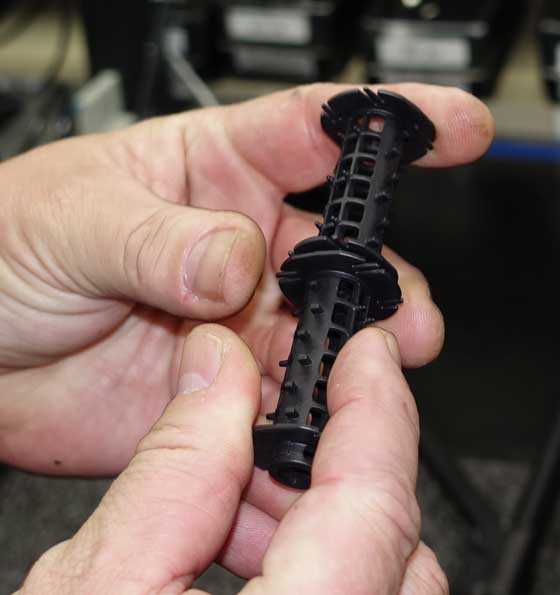
These spools are connected in line inside the silencer.
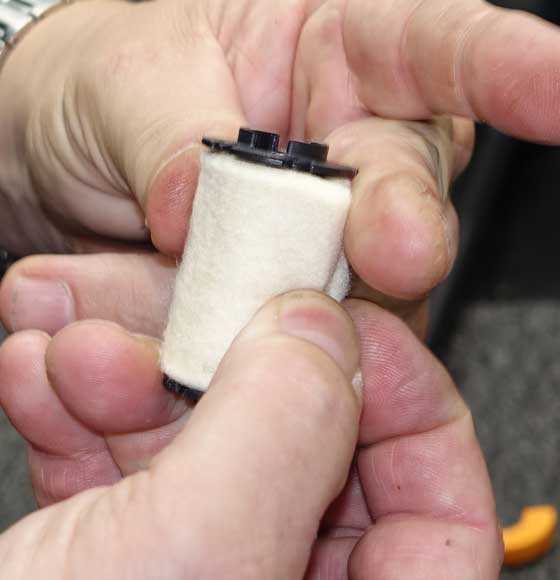
Each spool is wrapped with a felt pad.
Reader Red Beard Forge said the following about the silencer.
“Hi B.B. is the silencer removable? I am really intrigued by this gun but living in Canada any silencer is considered a prohibited device. If the silencer can be removed entirely or if the baffles inside could be removed it would be much easier to get one of these rifles into the great white north and comply with our far more restrictive laws on airguns (all airguns are considered firearms, but the licensing requirements are waived if the velocity is under 500 fps, so the legislative loophole that allows silencers on airguns in the states doesn’t work up here).
The power issue is less of a problem as most Canadians involved in shooting sports also have a firearms license. I have personally imported a high power air rifle from the states and had no problems whatsoever. I did it in person at a border crossing. I just showed them the specs of the rifle and my firearm license and they sent me on my way after checking the computer system to make sure that the model I was importing was not prohibited in Canada.”
I can tell you that the silencer is not made to disassemble, so Sig would have to build rifles without the silencer’s guts. They might also have to alert the RCMP they were doing that for the rifle to be accepted in Canada. I have no idea if they plan to do that, but I can tell you they are considering it, because Sig never misses a beat when it comes to marketing.
Accuracy
Ed Schultz called me the day before Thanksgiving last week to ask if I had received my rifle and how did I like it so far. As we talked he said I might want to clean the barrel early on and see what that does for accuracy. He said some guns respond to a barrel cleaning and others don’t seem to.
He said to clean it with a bore brush and patches but to not go as far as to use JB Non-Embedding Bore Cleaning Compound. He said I might see some soot on patches if I cleaned early on. Or I could just keep shooting and eventually the pellets would clean the bore themselves. I will keep that in mind when we get to the accuracy test.
Tools
Besides the rifle, Sig packs some tools for your use. There are a screwdriver and an Allen wrench to adjust the trigger, and in my case, since the rifle came with a scope I got the Torx wrench for the screws on the rings. I got something more with the scope that I will now discuss.
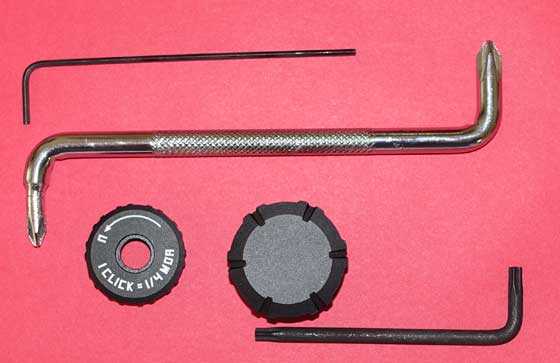
The tools for the rifle and for the scope came in the box. Sig even bent the trigger adjustment screwdriver so you can adjust the trigger with the scope mounted! The scope knob and cap and the Torx wrench at the bottom are for the Whiskey3 (see text).
Whiskey3 ASP 4-12X44 scope
As mentioned in Part 1, my rifle came with the Whiskey3 ASP 4-12X44 scope mounted. This scope is made for the ASP20 and does something airgunners have waited a long time to see. It is ballistically matched to certain pellets, allowing the shooter to just dial the distance to the target and the pellet will always strike at the intersection of the crosshairs.
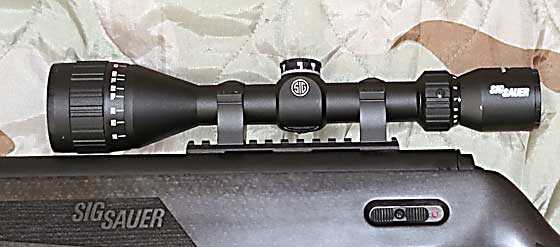
Sig makes the Whiskey3 ASP 4-12X44 scope specifically for the ASP20 rifle.
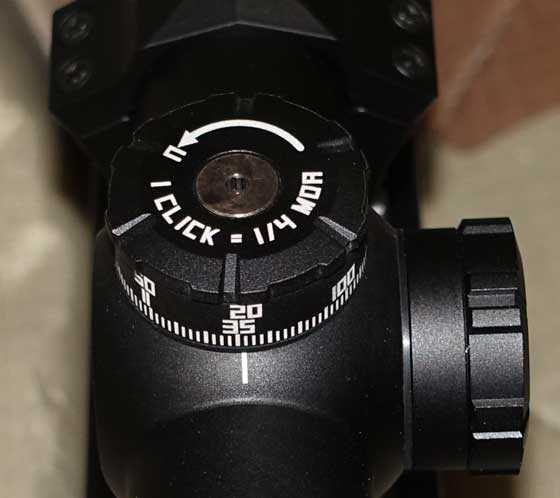
The elevation turret is calibrated in yards. Note that 20 yards and 35 yards are at the same setting. I have been writing that for 20 years and now we see it graphically. The same adjustment covers all shots from 20 through 35 yards.
The vertical crosshair adjustment is calibrated in yards to the target rather than just having simple index marks. Once you have sighted in with the right pellet, just dial the turret to the distance to your target and put the crosshairs on what you want to hit. I tried it when I shot the rifle at Sig this past July and my rifle was dead on. I started shooting at 10 yards and was dead on target. Then I moved to 35 yards, adjusted the scope turret and was dead on again. Then I shifted to 50 yards, adjusted the scope and put the pellet through what I was aiming at. Ed Schultz was watching my target through a spotting scope, and, when I shot at 50 yards and hit what I was aiming at, I wanted to go again. He said he would spot me, so I fired at the pellet hole. This was on a large Shoot-N-C target that was clean, so wherever the pellet hit would be visible. Ed was not able to see the pellet hole grow! Either I aimed off the target entirely or my second pellet went through the first hole!
The pellet the scope is calibrated to is Sig’s Crux Ballistic Alloy dome. But I found them hard to chamber, so I switched to JSB Exact Jumbo domes and they were the ones I used to shoot the targets. So I know which pellet to test in my rifle!
Can the scope be used without the ranging system?
What If you don’t want to use the ranging system of the Whiskey3, or what if it doesn’t match the trajectory of the pellet you want to shoot? Sig sends you a standard MOI adjustment knob (see the picture of the tools, above) that replaces the yardage knob. The scope is calibrated in 1/4 MOA clicks, so the switch is not difficult.
The scope adjusts for parallax down to 7 yards and out to infinity. The index marks on the objective bell from 10 yards to 50 yards occupy half the circumference of the bell, so there is some range finding capability for Hunter field target, though 12 power doesn’t give a lot of resolution. All things considered, the Whiskey3 is a well-thought-out airgun scope.
Summary
I will end the description here and get into velocity testing next time. This promises to be a great air rifle and scope combination!

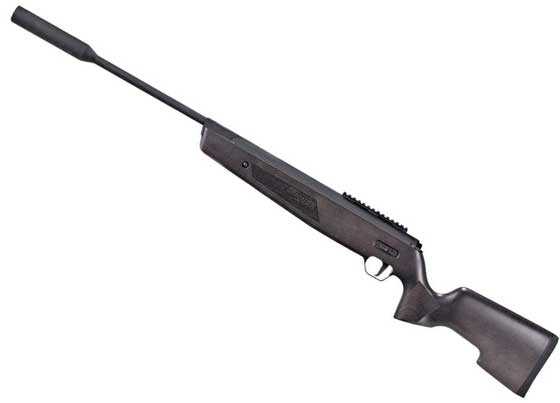
BB
I am led to believe that silencers for real firearms reduce noise by cooling down hot air leaving the barrel and slowing it down at the same time reducing a shock wave. I know that airgun air can be hot enough to detonate oil at some point but do these silencers work on reducing any hot air or is it just concentrating on noise alone. Or does it still handle both at a lesser degree?
Those Sig people must be burning the midnight oil to redesign and improve airguns or innovation is highly rewarded. Hats off to them. Black wood captures the look of high tech synthetics while maintained the traditional benefits of wood though I’m sure it disappoints people who prefer the natural wood look.
Bob M
Bob,
Both the gases of the firearm and the air of the air arm have energy. The idea is to allow this energy to be expended as work through the baffling, thus slowing the gases and provide a contained space for the expansion of the gases.
I am not sure I said that very well.
Silencers for firearms are usually much larger than what you see in the movies, depending on what you are “silencing”. The “silencer” on my RAW HM1000X in .357 is about a foot long and over an inch in diameter and I would not consider it backyard friendly.
RR
And that’s a hard core Airgunners rifle for sure. Yes and they obviously absorb a lot of heat. Snipers always have then covered.
“REAL firearms?” Please stop doing this! By this I mean somehow relegating air arms to an “unreal” category; usually expressed as a bifurcation between “real guns” and airguns.
Air guns are real. They are not fake although one can ponder this for airsoft, I’ll guess? Air guns are capable of causing extreme damage and death is used incorrectly. They are very real weapons and should not be considered as, somehow, less than “real guns.”
Air guns are NOT firearms. The difference as I have pondered it is that powder weapons produce an energized and moving projectile by virtue of the ammunition whereas air guns produce an energized and moving projectile by virtue of the energy produced by the gun itself. The energy and movement of the projective is, in either case, very REAL – particularly to the target.
While those of us who are avid air gunner know this, we need to correct the misunderstanding of many people who consider air guns as something less, and less dangerous (when used incorrectly) than firearms. Air guns are weapons. They are real and can be lethal. The same Real Rules of arms safety appertain to them ALL.
LFranke,
Now, now. Let’s be kind. I hold my tongue when many people talk about “powder burners.” The language, she is a-changin’. 🙂
B.B.
LFranke
The discussion was about silencers and hot air and perhaps I simply should have said ‘a real silencer’ instead of the words I used. I understand your dislike for using that word but I believe it is necessary at times when you are comparing duplicate looking items.
Notice I used the words ‘real firearm’, not ‘real gun’.
An airgun silencer cannot be used on a real firearm and does not function like one it is a faux silencer and I wanted to make it clear which one I was referring to.
For example you put a Colt M4 on a table with a HellBoy. They are both ‘real guns’ as you would like to have them called and they are, but in comparison, one is a real Colt firearm and the other is a faux Colt firearm. Because they look identical, but are not in function, you must make further clarification if you are discussing firearms one is real the other is not.
Now to be fair you can turn it around if you are discussing Airguns the Colt would not be a real airgun even if it is a real gun !
If a police officer catches you walking around a mall brandishing a HellBoy what’s the first thing you are going to say to him ? It’s not a real firearm !! …. You need clarification some times.
True they all look like guns and fire projectiles, even the same caliber, but I believe the term firearm and airgun still have a need for use in situations of legality and function.
Appreciate BB jumping in on this below.
Bob M
G’day BB
“Or I could just keep shooting and eventually the pellets would clean the bore themselves.”
Pellets don’t clean the Theoben Eliminator long term?
Cheers Bob
Bob,
It depends on the power and the pellet, of course. You refer to leading, which this rifle will do because of the power. But that takes a long time, if the bore is smooth.
B.B.
B.B.,
Very interesting on the scope turrets. I have seen custom turrets available in the firearm arena, but have never delved very deep into the topic. It reminds me of the 1st and 2nd zero points in a pellet’s flight trajectory. Looking forwards to more on this innovative air rifle and scope.
Good Day to one and all,…… Chris
Chris,
The first and second zero points is exactly what we are talking about. This scope illustrates it.
B.B.
B.B.,
That is the first time that you stated/verified that the turrets (on this rifle/scope) are meant to work that way,…. that I re-call. Perhaps some elaboration on that point in the next installment? That might be an attractive sales point (as opposed) to using mil-dots for some shooters..
In fact, perhaps an article on this type of turret in general? Also,… could one not make their own with tape? Just some thoughts. I could see field target shooters already doing something like this. Sorry I am not more informed on the topic.
Chris
Chris,
No, I did cover it in the 4-Part Sig visit. But now I will test it for you.
B.B.
B.B.,
It appears that you did in Part 3, mentioning that you could set the scope at whatever yardage you were shooting at and still hitting dead on. I just re-read it.
(Thank you). I do think that more people need exposed to this concept of marked turrets and simply clicking your way to the bull. I see this differing from conventional turrets,.. in that they can (do the same),… but are not marked as such. Plus, what to do if a heavier pellet is used? Or lighter? A heavier or lighter pellet will have different 1st zero and 2nd zero points,… which this is based on. Does the turret simply lift off, moved a bit and set back down until it is on? And, with second focal plane scopes,.. if the magnification changes,.. then also does the holdover. So,… the same principal would seem to apply,.. maybe? If you change the magnification (only),.. then the marked range on the turret no longer applies,… maybe? A marked turret sounds very pellet/gun specific.
So yes,… perhaps a bit more on the topic.
Hey,… just trying to “distract” you a bit! 😉
Best wishes and prayers that all is good for Wed.
Chris
Chris,
Seems to me that the range for which an airgun is used, 10 to 50 yards say, one would be better served just using the mil-dots. Unless one is using a range finder, the range is still estimated unless strictly target shooting from a bench. Also, I wonder how accurate the tracking would be in a less expensive scope? For me, I would rather use a 2 mil-dot hold over at 50 yards instead of turning the vertical adjustment knob 16 clicks upward. Just doesn’t make much sense to me with short ranges and arcing pellets.
Geo,
Good points. And there in lies the debate. Some people are “clickers” and others are mil-dot users. I am of the latter. A fine mill dot will go a long ways. On the other hand,.. other’s may feel that clicking is more precise. I do believe that B.B. is a fan of the clicker crowd,… if memory serves me correctly.
Don’t trust me on that though as (I) do not even trust me on that! 😉
Chris
Geo,
As an added thought,… putting the crosshairs on the bull every time,… regardless of range,… would result in more precise shots. Mildots on the other hand leave room for “interpretation” as to if I am doing a 2 and 3/4 or a 2 and 5/8 holdover. My best scopes have only 1/2,… so if I split the difference,… I can “guess” at a 1/8 increment. On the flip side,…. a fixed click point is a fixed click point. Precise markings per click is all that is left to guess/determine.
Chris
Okay, I get what you are saying. But if I zero my Urban at 32 yards my PBR is 12 to 35 yards with a 1/2″ killzone. At 50 yards the POI is -2.4″ or 1.4 mil-dots at 10X. If one were to use turret clicks to zero at 50 yards, would that not be about 38 clicks? In a hunting or pesting scenario that would seem impractical. And again, on less expensive scopes, is the tracking that accurate?
My thinking is that the less one adjusts the scope, mag or turret clicks, the better the results will be. Your thoughts? It is an interesting subject though.
Geo,
That is my gut too. The less, the better. It will be interesting to see B.B. weigh in on the pro’s and con’s of range marked turrets like this has. I would agree too that cheaper scopes may not have the ability to repeat. Going past and then coming back is pretty standard,…. be it objective lens/side parallax or W/E turrets or magnification. I must admit,… I forget to do that when turning something.
Chris
Chris,
Here is an excellent example of using turret elevation clicks to zero POI at long ranges. Matt Dubber from South Africa and a couple of other guys are shooting FX airguns with Night Force scopes and scope stickers. They are shooting pigeons at 130 to 150 meters! They are also shooting slugs, not pellets. They have some very serious money rapped up in their equipment too. It does demonstrate the possibilities of using the turret clicks though. Matt has won shooting competitions here in the US. I found the video to be quite interesting. I could only dream of having that kind of equipment.
Gee Chris, I just noticed I forgot to post the link to the video…duh. Anyway, here it is if you would like to view it. It is quite interesting that airguns can be very effective at 150 meters.
https://www.youtube.com/watch?v=xJwwLYZd6Bs
Geo,
That was some good shooting. That FX mag is huge! That is one thing I did not care for as I believe that same mag is used on other rifles, though with that bullpup it seemed ok. Nice example of using yardage marked turrets towards the end. I like it. Also note that he mentioned elevation and air temperature. I suppose the turret could be lifted off and repositioned if it would allow.
Combined with the range finder they were using,… it made for quite the effective set-up for targets at fixed points (wire) but an unknown distance. A .25 PCP will shred a steel can at 100 yards and knock it 5′ up and 10′ back with a good hit.
Thanks,…. Chris
Geo791,
George, 1 MOA is actually 1.047″ at 100 yards, however, most scope manufactures round that figure off to one click equals .250″ at that range. At 50 yards (one half), your scope will require twice as many clicks to move the POI the same distance as it would take at 100 since the click value is only .125″ at the 50 yard reduced range. 38 clicks would move your POI + 4.75″ at 50 yards, if you were – 2.4″. At 25 yards, 38 would be about right since each click at that range would be .0625″.
Bugbuster
Yes, you are correct. It would take 19 clicks at 50 yards to adjust the POI with 2.4″ of drop. Lost my head for a minute…maybe a senior minute? Thank you for replying.
I think clicking won’t mess up the mil dots while zooming. It’s not a ffp scope.
Edw,
Most scopes are SFP and adjusting the magnification will cause you to have to change hold overs (use of the mil dots). The FFP is the one that allows the same hold over/mildot use regardless of magnification. Clicking on either would have no effect on the mil dots as clicking is just replacing having to use the mildots for compensation.
Chris
That is what I said right?
Edit: I get you. The clicking will keep the cross hairs on target, and the dots aren’t used.
BB
I like the scope.
BB,
Now let’s see, first I have to buy the ASP20, with the scope of course. I am also going to need to buy a good quality rangefinder to go with it. A proper case will be needed…
Just so you know, you are making it very difficult for me to reduce my airgun collection. You are indeed “The Great Enabler”.
Our prayers are with you tomorrow.
B.B.
20% off!!!!!!
Could of, should of, would of….
-Y
B.B.,
You will have to show us a picture how the trigger is adjusted while in the gun. The only picture I could find of how to adjust the trigger showed it while separated from the gun (/blog/2018/08/my-day-at-sig-sauer-part-2/)
I sure wish this was something I could simply purchase.
Siraniko
B.B.,
I’ve always been impressed with Sig’s firearms; they’re of high quality and reliability with great attention to detail.
Now it appears they have brought all of their engineering wizardry over into their airgun production.
I only wish more airgun manufacturers would follow their lead.
Still praying for you,
dave
BB
I would stay away from using cloth patches if you choose to clean the barrel. Too easy to come off a cleaning rod and get stuck in the silencer compartment. Learned this the hard way on a Stoeger ATAC.
Deck
Deck,
I asked Ed about that. If you use a rod with a slotted head the patches should stay on. But you are correct — it is a concern.
Maybe a bore snake would be better.
B.B.
BB
I was using a rod with a slotted head when the cloth patch came off. The bore snake should be okay if this rifle likes to be cleaned.
Deck
I use a jag going from muzzle to breech with all my springers. Only one pass. Never lost a patch in there.
Glad you never had a patch get caught in the baffles. I avoid using a rod from the muzzle end to protect the acciracy sensitive crown. If the gun’s design forces me to I just use a bore snake.
Decksniper & Edw,
Here is a very good video by Steve Scialli at AEAC demonstrating his airgun cleaning procedure before testing and reviewing all airguns. He uses a Patchworm cleaning kit which would appear a very good option the barrel required cleaning. https://www.youtube.com/watch?v=5xu6ZnX7q4M
Geo
Geo & Edw
Geo, thanks for posting the interesting video. I did not know about PatchWorm and Weedeater string. Using a straw is a clever trick too. This guy is really into cleaning!
Thanks,
Decksniper
You should subscribe to the AEAC YouTube site by Steve Scialli. He does excellent reviews on airguns of all types. If there is a particular airgun of interest you can scroll through his video reviews and possibly he has done one. I have not seen him do any pistol reviews though. His reviews are some of the best I’ve seen.
https://www.youtube.com/user/svscialli/airgun-videos
https://www.youtube.com/channel/UC_yL99JCgr6x4NZtjW4_VvQ
Geo,
Thanks for the link. I look forwards to checking it out in the near future. Saved to favorites. A quick spot watch looked very interesting. I am very interested to hear the whole story. I can see a definite benefit for higher FPS PCP’s,… maybe? I think that higher fps gun cleaning is fairly well established. Now,… what is the “best” way?
Chris
B.B.
Praying for you this morning.
I hang on to God’s invitation to “come boldly” before His throne and so ask for His blessing for your well-being. So much of *being Christian* is caught rather than taught, life in the ordinary. You are a fine example of such. I look forward to good report when you return to this blog.
GrandpsDan
GrandpsDan,
Thank you for those kind words.
Caught rather than taught — I like that! 🙂
B.B.
BB’
Didn’t you report that the Whiskey 3 scope would be deeply discounted when bought as a combo? I don’t see an ASP20 offered as a combo at PA and I seem to recall that the savings that you reported on the scope was more than 20% of the ASP20’s cost, ( $200 savings as a combo compared to $70 as a 20% discount on the gun) so wouldn’t waiting for the combo be the more economical choice if you also wanted the Whiskey 3?
As of 9:00am EST Pyramyd still had the Cyber Monday sale in the banner at the top of the page for the ASP20 so the 20% may still be available.
Half
Half,
The Whiskey3 is not available yet. The rifle is, but the scope hasn’t come in yet.
B.B.
B.B./ ALL
Just an FYI, the PA Cyber Monday Sale doesn’t expire until 11/28 @ 3pm EST per PA’s site.
Doc
BB
I noticed a very slight difference in the stock combs of the wood and synthetic.
The wood stock seems to taper down toward the grip and a line drawn on top would intersect the safety cut out and the synthetic is more rectangular with a line intersecting the top of the forearm. Is the stock comb actually low enough to mount the scope that low and be comfortable on the wood version?
I’ll bet they did it intentionally to perfect the combo set-up.
Speaking of which I wonder if they are waiting till after Christmas to come out with the combo because the discount on the package deal could not tolerate another holiday discount. Just a thought.
It’s very, very nice to see SIG debuting with such an innovative and well thought out product. (Compare with the badge engineering of Remington, Browning, Ruger airguns!).
I’d love to see how exactly the trigger works. The trigger lever works like a Mauser alright, but i see a lot more going on in the cutaway?
At 20 fpe, it would make a good AAFTA piston hunter field target gun if it proves accurate at 50 yards. At 12x , though, I’m not sure the Whiskey scope will range find good enough to tell that you’re at 50 yards.
Brent
Can you tell us about the fit and finish of this very exiting air rifle. Currently in the U.K. It’s for sale at $660 of your dollars. (£519)
Fruity,
Welcome to the blog.
Fit and finish? I will try to work it is the next report, so keep reading. But I already covered the fit of the breech in great detail.
B.B.
Thank you. I hope all is well.
Rather than the rifle’s breech lock up I was asking about the finish of the rifle. Function and form.
I love an accurate rifle, but I really love an accurate beautiful rifle. Perhaps they could do an export model.
Hats off to Sig they have designed a spring rifle from the ground up, Airarms and HW haven’t done that for a while.